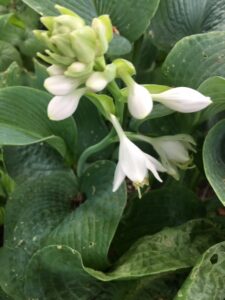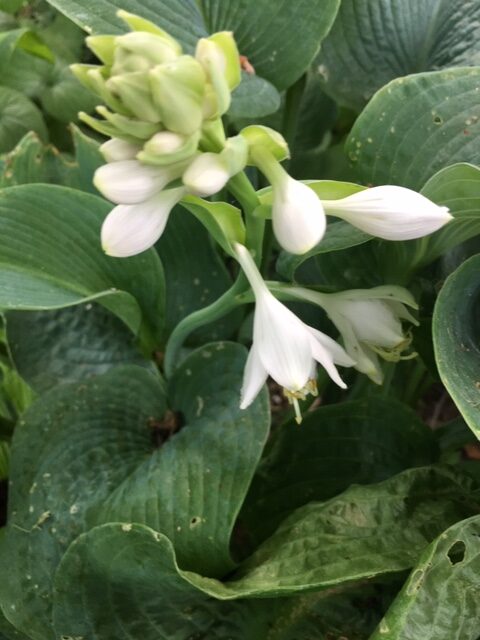June 18th 
The 169th Day of the Year
The heaven is now broad and open to the earth in these longest days. The world can never be more beautiful than now.
Henry David Thoreau
Sunrise/set: 5:06/8:06
Day’s Length: 15 hours
Average Hi/Lo: 82/61
Average Temperature: 72
Record High: 98 – 1944
Record Low: 47 – 1903
Weather
Indicative of summer stability and the dominance of high pressure at this time of year, 75 percent of June 18ths are without rain, and the sun appears 90 percent of the years. Temperatures are mild: in the 70s thirty percent of the time, in the 80s sixty-five percent of the time, with just a five percent chance of 90s. Evening lows are usually in the 60s, with cold 50s occurring 30 percent of the years.
Natural Calendar
Some multiflora roses and Japanese honeysuckles are dropping petals now, but August’s wingstem and tall coneflower stalks are five feet high. Virginia creeper is flowering. Many Canadian thistles and nodding thistles start to go to seed. Orchard grass is getting brown and old, English rye grass full bloom, exotic bottle grass late bloom, brome grass very late, but some timothy still tender. Throughout the Lower Midwest, winter wheat is gold or browning. Clustered snakeroot and honewort are seeding as avens and wood nettle begin their seasons. Bamboo grass has fresh growth, and July’s wood mint is budding. In the Southeast, the kudzu vines are ready to blossom.
Daybook
1982: Last pint of strawberries picked. First small dish of black raspberries. At South Glen, parsnips, angelica, yarrow and tall meadow rue still dominate the fields. Milkweed is starting to flower, first milkweed bugs discovered. Blueweed found in bloom along the railroad tracks, water horehound flowering in the swamp. Honewort strong in the woods.
1983: First black raspberry turning a light shade of red. Chicory bloomed today. Mulberries ripening. Quickweed is open in the garden. Peak of privet blossom. Three young groundhogs, maybe eight weeks old, seen along Grinnell Road.
1986: Cardinal sang at 4:04 a.m. First pokeweed opened.
1987: The 17-year cicadas disappeared as suddenly as they came, the woods quiet. In the yard, all the strawberries are gone, black raspberries peaking. North along the railroad tracks: first catmint seen in bloom, poison hemlock going to seed, leather flower identified – Clematis viorna, lush. At Caesar Creek three carp caught up the channel at Far Hole. Wild petunia seen at South Glen, timothy bearded with pollen, hemlock going to seed, water willow full bloom. Young geese half grown, moving in an extended family, four adults, five goslings. Groundhogs seen by the side of the road, a third grown. One indigo bunting identified. And I’m full of chiggers after a day walking.
1989: Walking South Glen, I left the path and wandered from one small glade to another. I felt a sense of intimacy with myself in those enclosures. The sun so hot, air still a little cool, but no breeze inside the hollows with their timothy and bottle grass, surrounded by thick Osage and honeysuckle. I was relieved to be isolated, out of sight, private in the sudden absence of the outside network, in the liberation of protecting woods.
1990: Veronica, astilbe, and coral bells full in the east garden. Four lilies have opened so far. One broccoli plant ready to eat. A few strawberries left. The very first black raspberry ripe. Privet flowers are gone. Primroses hold. Mallow is budding.
1991: Purple loosestrife blooms in the yard, probably a week earlier along the Ohio River in Switzerland County. First stag beetle came to the porch after dark.
1993: Black walnuts half an inch to an inch in diameter. Osage fruit, blown down in the storm last night, is maybe a fifth of its autumn size. Bing cherries found ripening at the south end of town.
1995: Yellowstone: Low elk thistle, field chickweed, cow parsnip, woodland strawberry, western cressleaf groundsel, glacier lily, water hemlock, common yellow monkey flower, violet goosefoot. Aspen leaves the size of my thumbnail.
1999: Bangor, Maine: Potentilla, tansy, early pink spirea open. Foxglove budding. White campion seen, strawberries ripening (their festival is June 26th, three weeks later than a Yellow Springs festival would be). In Vermont: deep green wheat.
2000: Portland, Oregon, and to Astoria and Cannon Beach, June 18th through the 21st: Litany of plants telling time: mid-season cow parsnip, Scotch broom (yellow pea-flower shrub) in full bloom. Tall pussy toes everywhere, tall buttercups, peonies and poppies at the ocean, late rhododendrons (Pacific rhododendrons) along Highway 26, full roses, clovers, alliums, small-leafed dock, yucca not blooming but ready, cattails just emerging, full yarrow, coastal thistles six-feet tall and budded, elderberry – many with fruit set, common purple vetch, seacoast lupine and wild purple foxglove very prominent, California poppies, chicory, redwood sorrel found, but not in bloom, goat’s beard, early catalpas, Rugosa type “Wood’s rose” full, thimbleberry shrubs in bloom, maybe a third had set fruit, full blackberry flowering season, Rubus ursinus and Spirea densiflora full, early teasel without blooms, white sweet clover, full moth mullein, Canadian thistle, Queen Anne’s lace.
2001: First purple loosestrife, first avens. First pale blue-bodied dragonfly at the pond. Chiggers have attacked me!
2004: To Madison, Wisconsin, the day clear and cool: The landscape is uniform throughout the trip: parsnips, chicory, elderberry, crown vetch, yellow and white sweet clover, trefoil, milkweed, hemlock, daylilies, wheat all turned, corn about knee high everywhere, red-winged blackbirds still sitting on the fences, guarding their territories.
2007: Small white bindweeds blooming in the alley yesterday and this morning. Jeanie heard the first cicada this morning, short, intermittent calls. The birds were quiet today, only one grackle baby being fed by a parent, very few birds around. A few chigger bites have appeared on my legs – the first of the year.
2009: Jeanie reports the first chigger bites.
2012: One monarch this afternoon in the zinnias. Seventeen varieties of lilies in bloom today. Pink spirea color starting to break down. All the yucca flowers gone, large seed pods in their place. Some corn up to my armpits along Dayton-Yellow Springs Road. A very quiet walk this evening – not a single bird song heard.
2013: Castelluccio, Italy: We arrived at the beginning of the first phase of the annual wildflower bloom, two weeks after the time we came in 2011, but too early for the best flowering. Still, there was plenty to find: field after field of lintels in their yellow and yellow-green bloom; drifts of orange poppies (Papaver commune rhoeas); the tall blue Fiordaliso (cornflower or Cyanus segetum Hill); common daisies big as the cornflowers; a variety of the six-petaled, white star of Bethlehem, most likely an Omithogalum umbellatum; the single flowers of the Bistorta officinalis Delarbre that look like puffy, pale violet plantain stalks; Campanula rapunculus; Verbascum longifolium, a lanky giant mullein; the ubiquitous ginestra; red clover, white clover; the divided white five petals of the Cerastiums (Caryophillaceae family); buttercup: Ranunculus brevifolius; a pink Anacamptis pyramidalis (Orchidea permidae); a forget-me-not type flower with heavy, hairy, entire, toothed leaves; and iris were in full bloom in the Castelluccio town square.
2014: The first heliopsis is unraveling.
2015: Santee-Cooper, South Carolina: In the middle of a heat wave, highs in the 100s. One yucca plant noticed at about the same stage as yucca in Yellow Springs. Where we fished, I found fine-leaved sneezeweed (Helenium tenuifolium) full flower, and the large violet kudzu buds just starting to open (the vines having covered all the hillsides and shoreline area on both sides of the canal).
2016: A brief walk at Gethsemani in Kentucky: No wildflowers in the woods, one white-spotted tick picked up, one tattered black swallowtail seen. The dramatic part of the walk: The first five of dozens of white American Lotus buds were completely open, big as a head of lettuce, at one of the small lakes here. Returning to photograph the flowers, I saw a younger black swallowtail.
2017: Along Limestone Street: black walnuts fragrant, rough-hulled, an inch and a half long, fallen peaches the size of black walnuts, buckeyes the size of marbles. The Stella d’oro bloom in the yard is in retreat, twenty-two in bloom this morning, the majority from a new clump on the north side of the house. Ditch lilies open: fifty-three blossoms, but the foliage in the dense patch of ditch lilies is dying back from lack of sun and overcrowding, Nine Asiatics, no rebloomers. The monarda is rapidly coming on, On Dayton Street, pink spirea plantings have completed their season. On Elm, golden coneflowers in full bloom.
2018: A male Eastern black swallowtail came to the hummingbird feeder this morning around 8:00 a.m., the morning so humid and warm, tree crickets so strong, the red admiral of the last days having ceded to the swallowtail.
2019: Finally, the lilies start to come in: nine Stella d’oros this morning and three ditch lilies. And a dozen heliopsis flowers round out this new season of summer. A black walnut the size of a cherry tomato on the sidewalk, fruit of days of rain.
2020: Mating cabbage whites. The first silver-spotted skipper. Another checkerspot butterfly. Three Stella d’oros, four ditch lilies. Pale brown starling twins begging from their parent, who dug out suet for them. Nodding thistles full flower along Dayton-Yellow Springs Road. Great blue hostas reach full early bloom.
I am owner of the sphere,
Of the seven stars and the solar year….
Ralph Waldo Emerson


